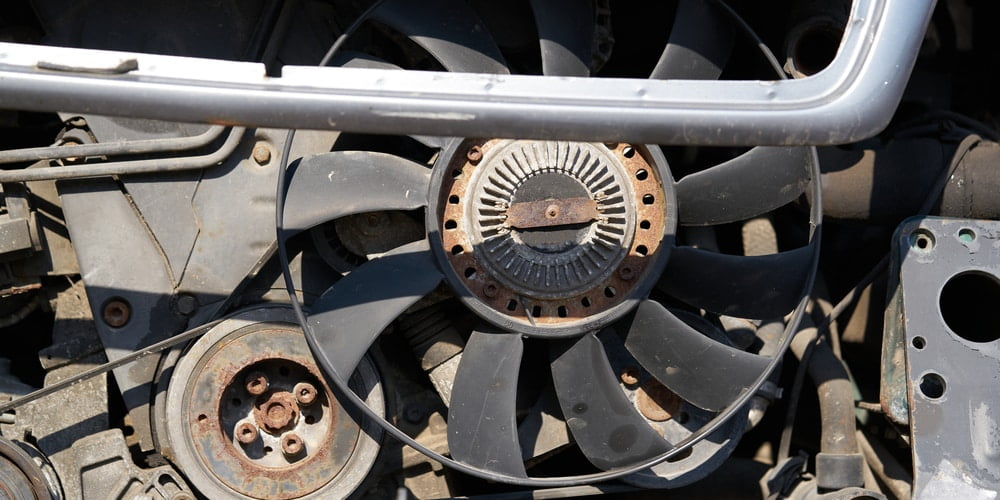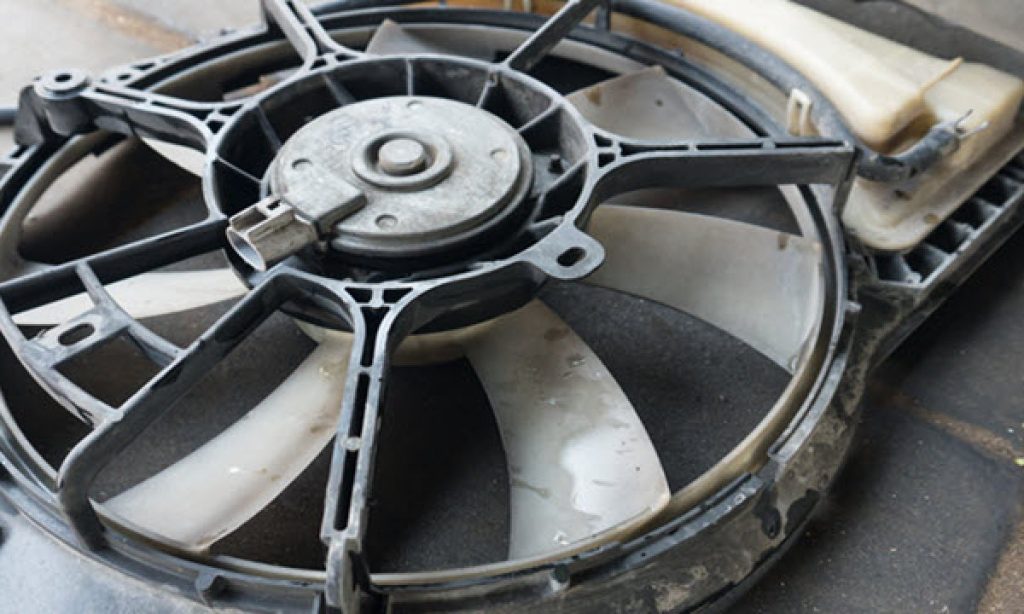Your engine’s health depends on one small yet crucial component the radiator fan. The car radiator fan plays a vital role in keeping your engine at an optimal temperature, especially during idle or slow driving. When it fails, the cooling system cannot regulate heat properly, leading to overheating and severe engine damage. Ignoring a faulty fan could result in costly repairs, including warped cylinder heads, damaged gaskets, or a complete engine breakdown.
Timely radiator fan replacement is the key to preventing these problems. It ensures the engine remains cool, protecting its performance and lifespan. Don’t let a failing radiator fan turn into a bigger headache watch for warning signs and take action immediately to keep your car running smoothly.
why your engine is overheating or your AC isn’t cooling?
If your engine temperature starts rising, your vehicle’s AC stops cooling, or you hear unusual noises under the hood, it’s time for a quick radiator fan replacement. Acting now can save you thousands in repair costs and ensure your vehicle’s reliability on the road. Wondering why your engine is overheating or your AC isn’t cooling? This blog will help you understand the importance of radiator fan replacement, the warning signs of a failing fan, and why timely action can save you from costly engine repairs!
What Does a Radiator Fan Do?
The radiator fan is the unsung hero of your car’s cooling system, keeping your engine at the perfect operating temperature. When your car moves at high speeds, air naturally flows through the radiator, cooling the engine. However, during idle or slow driving, this airflow is insufficient. That’s where the engine cooling fan comes in. It draws air through the radiator to regulate the temperature, preventing the engine from overheating.
Electric cooling systems
Modern vehicles often use electric cooling systems that activate the fan based on thermal sensors. When the engine reaches a certain temperature, the radiator fan turns on, ensuring continuous airflow to cool the engine. This precise thermal control keeps the engine from running too hot or too cold, preserving its performance and efficiency.
A failing radiator fan disrupts this process. Heat quickly accumulates without adequate airflow, leading to overheating, decreased fuel economy, and possibly serious engine damage.
The car radiator fan may seem like a small component, but its role is critical in maintaining your vehicle’s health. If you notice your fan isn’t working it should act fast.
Don’t risk engine failure! Book a professional radiator fan replacement today to keep your car cool and running smoothly. 🚗
Common Signs You Need a Radiator Fan Replacement
Don’t ignore the warning signs your radiator fan replacement could be overdue.
- Overheating Engine
If your engine temperature rises quickly while idling or driving slowly, it’s a strong indicator of a failing car radiator fan. Without the fan pulling air through the radiator, the cooling system cannot regulate heat effectively. Overheating can damage engine components like cylinder heads and gaskets, leading to costly repairs. - Non-Functioning AC
When your AC suddenly stops cooling, a faulty radiator fan might be the reason. The fan assists airflow through the condenser, helping the AC perform efficiently. Without it, you’ll notice warm air blowing from the vents, especially when the car is stationary or moving slowly. If your AC isn’t working as expected, it’s time to check for a necessary radiator fan replacement. If cabin air turns warm at idle, here’s why Car AC repair services are crucial in Dubai and how AC + cooling work together. - Loud Noises
A properly working engine cooling fan operates smoothly and quietly. If you hear grinding, clicking, or whirring noises coming from the fan area, it could mean worn-out motor bearings, cracked blades, or loose connections. These issues not only affect cooling efficiency but can also escalate to total fan failure if ignored. - Engine Warning Lights
Your car’s sensors detect overheating and other cooling system problems, triggering the check engine light or temperature warning light on your dashboard. If you see these lights accompanied by rising engine temperatures, the radiator fan may not be functioning properly. Immediate attention and a quick car radiator fan replacement can prevent further engine damage. - Visible Fan Damage
Inspect the radiator fan visually for signs of damage. Cracked or broken blades, loose wiring, or a worn-out fan motor are clear indicators that the fan needs replacement. Damaged components cannot provide proper airflow, leading to cooling inefficiency and engine overheating.
Ignoring these signs can turn a minor issue into a major repair. A failing radiator fan puts your engine at risk and can leave you stranded on the road.
Don’t wait for the worst to happen! If you’re experiencing any of these symptoms, schedule a radiator fan replacement today. Addressing the issue early will save you money, prevent breakdowns, and ensure your car performs reliably every time you drive.
What Causes a Radiator Fan to Fail?
A failing radiator fan doesn’t just happen—it’s usually caused by a range of underlying issues that affect your car’s cooling system.
- Electrical Issues
The most common cause of radiator fan failure is electrical problems. Damaged wiring, blown fuses, or a malfunctioning fan motor can prevent the fan from operating correctly. If the fan isn’t receiving power, it won’t activate, leading to overheating. Regular inspections and radiator fan diagnostics can help detect and fix these electrical faults early. - Wear and Tear
Like any other component, the car radiator fan undergoes wear and tear over time. Continuous operation, exposure to heat, and environmental factors can weaken the fan motor and blades. Cracked or warped fan blades disrupt airflow, while a worn-out motor may stop functioning altogether. Aging parts demand timely radiator fan replacement to maintain the efficiency of your car’s cooling system. - Coolant Leaks
Coolant leaks may seem unrelated, but they can stress the radiator fan and motor. When the engine overheats due to coolant loss, the fan works harder to cool the system. This excessive workload shortens the fan’s lifespan. Addressing coolant leaks promptly as part of car cooling system repairs can prevent further damage. - Relay or Sensor Failure
The radiator fan relies on signals from temperature sensors and relays to operate at the right time. If these components fail, the fan may not turn on, even when the engine temperature rises. Faulty relays or sensors can cause irregular fan performance, requiring proper radiator fan diagnostics to identify the issue.
Understanding these causes allows you to take preventive action before a failing radiator fan leads to bigger problems.
Don’t ignore the signs! Schedule professional radiator fan replacement and cooling system repairs to keep your engine running cool and avoid costly breakdowns. 🚗
Why Timely Radiator Fan Replacement Matters?
Delaying a radiator fan replacement might seem harmless at first, but the consequences can be far more serious and costly. A malfunctioning car radiator fan disrupts the cooling system, causing the engine to overheat. Excessive heat can warp cylinder heads, leading to poor compression, engine misfires, and even total engine failure. Repairing warped components or replacing the engine can cost thousands, making a timely radiator fan replacement a much smarter option. Overheating can also start with a stuck thermostat, spot the early signs here: What Are Bad Thermostat Symptoms? Early Action Saves Engine.
Ignoring a faulty radiator fan also risks damaging other critical parts of the cooling system. Overheating can compromise the radiator, cause gaskets to blow, and weaken hoses. These components work together to regulate engine temperature, and any failure can escalate into a costly repair.
Beyond mechanical damage, a failing radiator fan affects vehicle performance. An overheating engine cannot operate efficiently, leading to poor fuel combustion and diminished power. You may notice a drop in fuel efficiency and sluggish acceleration. The longer you wait, the more damage the cooling system suffers.
By replacing the faulty car radiator fan promptly, you restore proper airflow and thermal control, ensuring the cooling system works efficiently. This not only prevents overheating but also improves fuel economy, protects engine components, and extends the overall life of your vehicle.
Don’t let a small problem become a major repair! If your car shows signs of a failing radiator fan, act immediately. A quick radiator fan replacement can save you from expensive breakdowns and keep your vehicle running smoothly.
Stay ahead of the issue, replace your radiator fan today to protect your engine and enjoy reliable performance on the road. 🚗
How to Diagnose a Failing Radiator Fan
Suspecting a radiator fan replacement? Here are simple steps to diagnose the issue before it turns into a major repair.

- Check the Temperature Gauge: Turn on your vehicle and leave it running. Keep an eye on your dashboard’s temperature indicator. It’s possible that your car’s radiator fan isn’t operating if the temperature increases rapidly while the car is stopped or moving slowly. When the gauge rises, it means the engine isn’t being adequately cooled by the fan.
- Inspect the Fan Operation: After the engine has warmed up, carefully open the hood to examine the radiator fan. It should start rotating to pull air through the radiator. If the fan is not moving or stops intermittently, the issue is most likely with the fan motor or sensors.., signaling a need for radiator fan replacement.
- Listen for Unusual Sounds: A healthy car radiator fan runs in silence. Unusual clicking, grinding, or whirring sounds coming from the fan may be a sign of internal damage, loose blades, or a failing motor. These noises indicate that the fan is having trouble cooling the area sufficiently.
- Look for Wiring Damage or Blown Fuses: Check for obvious damage to the fan’s wiring and fuses. The fan may lose power due to blown fuses or rusted wiring. A professional inspection can verify the problem if you are uncomfortable inspecting electrical components.
While these DIY steps can help pinpoint problems, not all radiator fan issues are easy to detect. Sensors, relays, or motor failure often require specialized tools for accurate diagnostics.
Don’t leave it to guesswork! If you’re unsure, schedule a professional inspection to confirm the need for a radiator fan replacement. Timely action will protect your engine from overheating and save you from costly repairs. 🚗
Radiator Fan Replacement Process | DIY vs Professional Service
Replacing a car radiator fan is necessary to keep your engine cool, but should you hire professionals to do it or can you do it yourself? Let’s dissect it.
DIY Radiator Fan Replacement
If you’re confident with basic car repairs, here are simplified steps to replace the radiator fan:
- Disconnect the Battery: Always disconnect the battery to ensure safety while working on electrical components.
- Remove the Fan Shroud: Unscrew and remove the shroud covering the fan to access the component.
- Detach the Old Fan: Unbolt the damaged radiator fan and carefully disconnect wiring or connectors.
- Install the New Fan: Position the new car radiator fan correctly, reconnect wiring, and secure it with bolts.
- Reassemble and Test: Reinstall the shroud, reconnect the battery, and start the engine. Ensure the fan operates when the engine heats up.
While these steps sound straightforward, improper installation can lead to electrical faults, fan misalignment, or cooling inefficiency.
When to Seek Professional Help?
For complex issues like defective wiring, relay issues, or motor failure, expert mechanics provide accurate diagnoses and solutions. Specialized tools and expertise ensure the new radiator fan replacement integrates perfectly with the cooling system.
Benefits of Professional Radiator Fan Replacement
- Precision Installation: Experts ensure all connections, wiring, and alignments are correctly handled.
- Diagnosis of Underlying Issues: Professionals can spot additional cooling system problems during the replacement process.
- Warranty and Reliability: Many garages provide warranties on parts and labor, giving you peace of mind.
DIY can save costs, but mistakes may lead to engine damage.
Don’t take risks with your engine! For a hassle-free and precise radiator fan replacement, consult a professional service today and drive with confidence. 🚗
Radiator Fan Replacement Cost in Dubai
Wondering how much a radiator fan replacement will cost in Dubai? Here’s a quick breakdown to help you plan.
Radiator Fan Replacement Cost in Dubai
| Cost Factor | Details | Average Price (AED) |
| Labor Fees | Varies based on vehicle complexity and disassembly required. | Included in total cost |
| Fan Quality | OEM (Original Equipment Manufacturer) parts are pricier but more durable. | AED 600–1,500 |
| Motor Type | Electric cooling fans cost more than older mechanical fans. | Varies by vehicle model |
| Total Replacement Cost | Full radiator fan replacement price, depending on vehicle make/model. | AED 600–1,500 |
Key Factors Affecting the Cost:
- Labor Fees: Labor charges depend on the complexity of the replacement process and the workshop you choose. Some vehicles require more disassembly, increasing costs.
- Fan Quality: High-quality radiator fans or OEM (Original Equipment Manufacturer) parts cost more but offer better durability and performance.
- Motor Type: Modern vehicles use electric cooling fans, which can be pricier compared to older mechanical options.
While cheaper alternatives might seem appealing, they often compromise performance and durability. Choosing reliable mechanics for radiator repair services ensures the replacement is done right, saving you from recurring issues.
In a place like Dubai, where extreme heat puts added stress on your cooling system, a faulty radiator fan can lead to engine overheating.
Don’t cut corners with critical repairs! Invest in professional radiator fan replacement to protect your engine and keep your vehicle running smoothly in Dubai’s challenging climate.
Preventive Maintenance to Extend Radiator Fan Life
A little care goes a long way in avoiding premature radiator fan replacement and costly repairs. Here are practical tips to keep your car radiator fan working efficiently:
- Regularly Inspect the Cooling System: Damaged hoses, leaks, or cracks can put stress on the cooling system, making the radiator fan work harder. Regular examinations might help spot small issues before they get out of hand.
- Check Fan Operation During Oil Changes: During routine oil changes, take a moment to inspect the car radiator fan. Make sure it turns on when the engine is hot enough to run. If not, it may be a sign of electrical or motor issues that need attention.
- Replace Fuses or Relays Promptly: Fan failure is frequently caused by blown fuses or malfunctioning relays. To guarantee that the fan gets the power it requires to operate, replace these parts as soon as possible.
- Flush Coolant Regularly: Old or contaminated coolant can cause overheating, putting unnecessary stress on the radiator fan. Maintaining an effective cooling system requires flushing and coolant replacement every two to three years.
By following these maintenance tips, you can reduce the risk of unexpected radiator fan replacement and extend its lifespan.
Stay proactive and maintain your cooling system today to avoid costly repairs tomorrow. Regular care ensures your radiator fan keeps your engine cool and running reliably. 🚗
Don’t Delay Radiator Fan Replacement
A failing car radiator fan is a small issue that can lead to massive engine problems if ignored. Addressing radiator fan replacement quickly prevents overheating, protects critical components, and keeps your car operating at its best. Timely replacement not only improves fuel efficiency but also saves you money on costly repairs for engine damage.
Don’t wait for your engine to overheat or break down act now!
Take control of your car’s health today. Schedule a professional radiator fan replacement at the first sign of trouble and ensure a smooth, reliable drive every time you hit the road. 🚗



